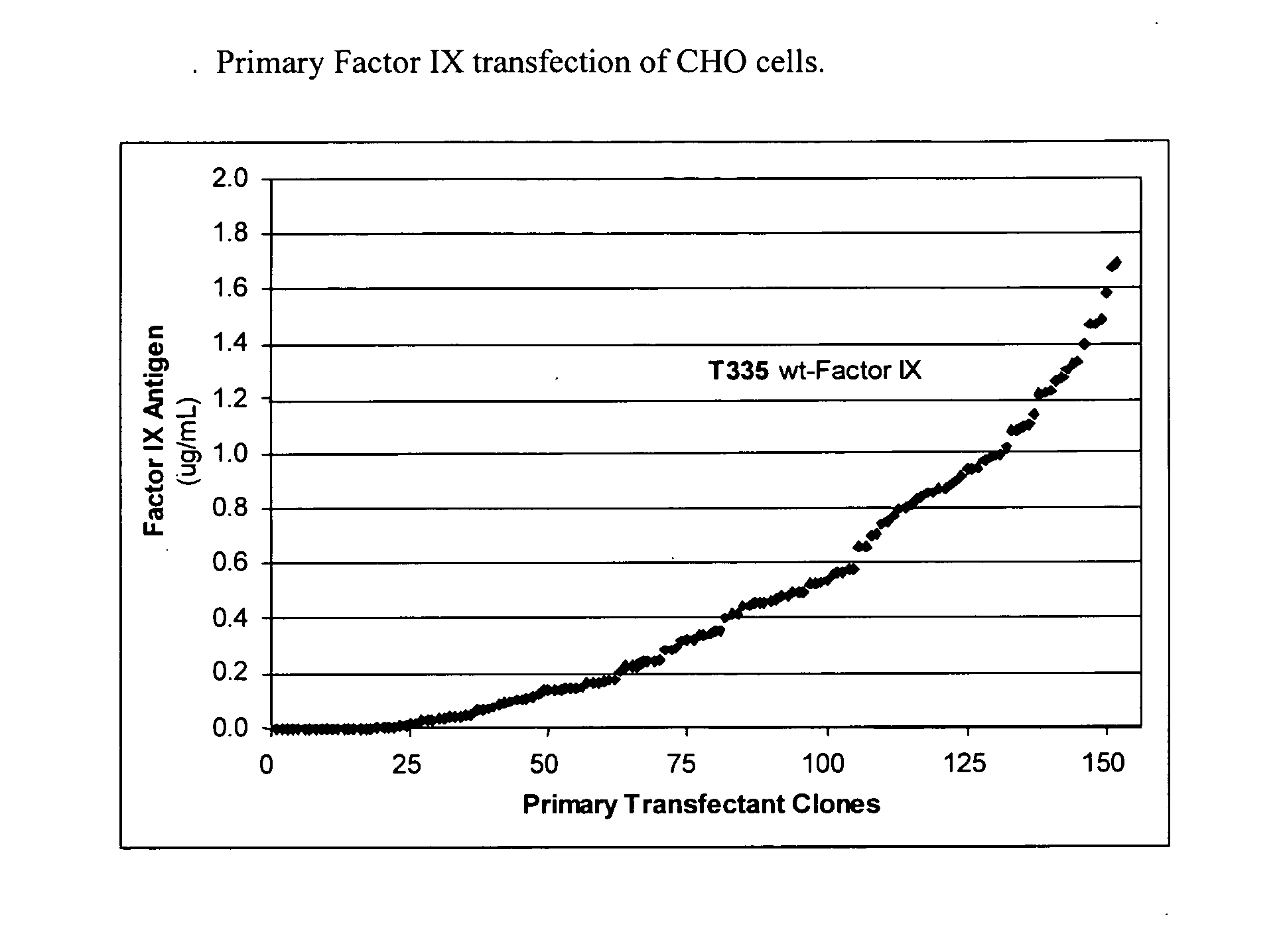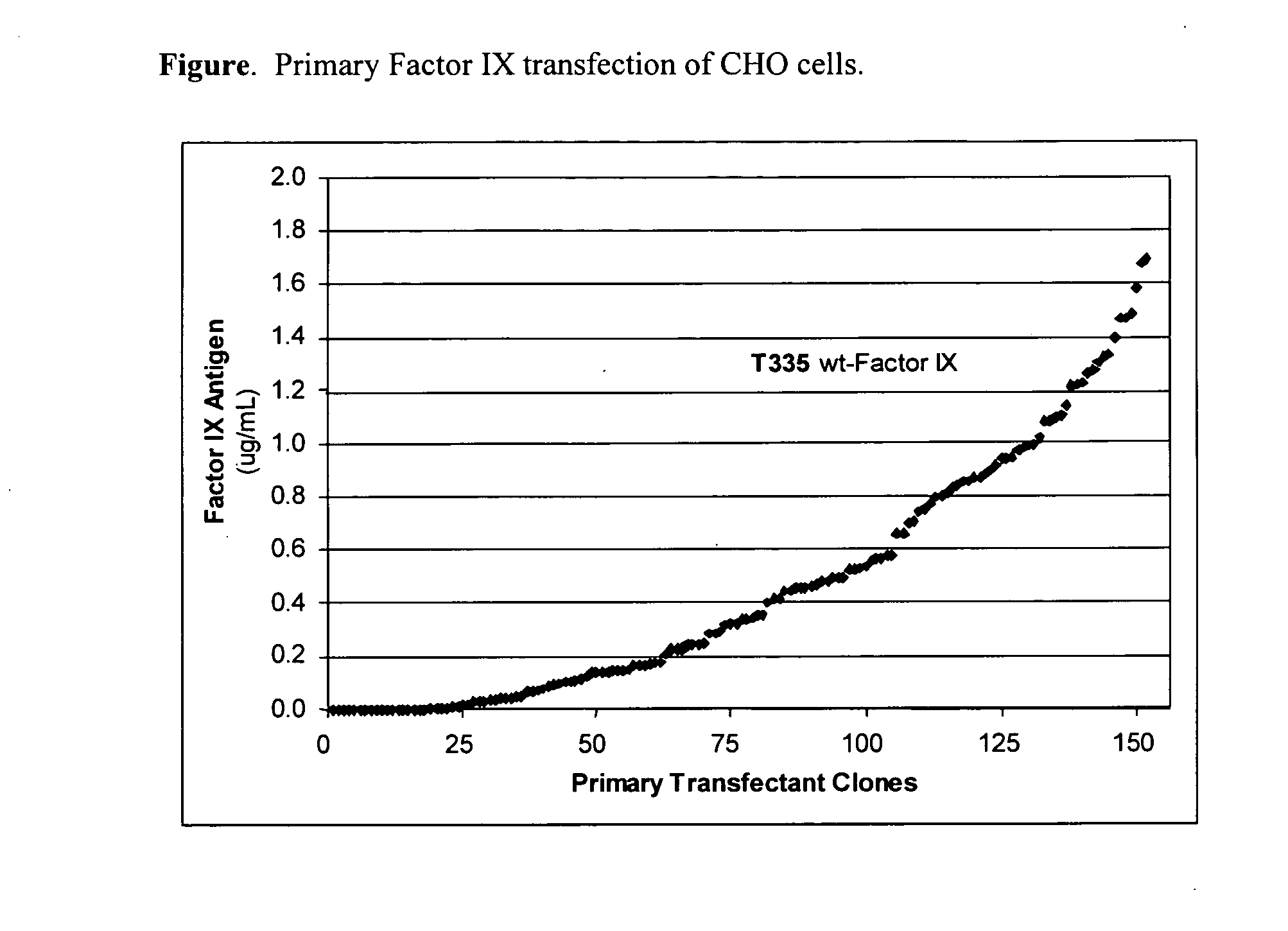Method of producing biologically active vitamin K dependent proteins by recombinant methods
a technology of biologically active and dependent proteins, which is applied in the direction of peptides, drug compositions, and infusion cells, can solve the problems of high cost, prohibitive routine management of bleeding, and limited treatment of bleeding disorders, and achieve the effect of facilitating the production of biologically active vitamin k dependent proteins
- Summary
- Abstract
- Description
- Claims
- Application Information
AI Technical Summary
Benefits of technology
Problems solved by technology
Method used
Image
Examples
example 1
Primary Transfection of CHO Cells With Factor IX Gene
[0103] A wild-type Factor IX gene was transfected into CHO cells by limit dilution into 96-well plates. The Factor IX gene was under the control of the CHEF-1 promotor. Cells were allowed to grow in 5% serum for 14 days. The cell culture medium was harvested and the total amount of Factor IX antigen in μg per mL was quantified by a Factor IX ELISA method. More than 150 clones were evaluated and the total amount of Factor IX produced per clone is reported in FIG. 1.
[0104] CHO cells transfected with the Factor IX gene produced Factor IX antigen which was detected by Factor IX ELISA. The amount varied significantly between clones. The range of total protein production after 14 days in culture was between 0 and greater than 1.6 μg / mL of culture medium. Although not determined in this experiment the Factor IX produced in primary transfectants was about 20% biologically active (data not shown) as determined in an APTT clotting assay u...
example 2
Supertransfection of Factor IX-Producing CHO Cells With VKGC and VKOR Genes
[0105] In order to increase the percentage of active Factor IX produced in Factor XI-transfected CHO cells, the primary transfectants were pooled, expanded in tissue culture and supertransfected with vectors containing cDNA for enzymes generally thought to be important for the efficient Vitamin K-dependent gamma-carboxylation of Factor IX. Factor IX producing clones were pooled in a shake flask and supertransfected with cDNAs for both Vitamin K-dependent gamma-carboxylase (VKGC) and Vitamin K-dependent epoxide reductase (VKOR). Individually supertransfected cells were grown by limit dilution in 96-well plates in 5% serum for 14 days. The total amount of Factor IX antigen produced per mL was measured by Factor IX ELISA. The amount of active Factor IX was measured by an APTT clotting assay using Factor IX-deficient plasma as substrate and plasma-derived Factor IX as standard.
TABLE 1Supertransfection of Facto...
example 3
Large-Scale Production of Large Quantities of Biologically Active Recombinant Factor IX
[0108] To demonstrate that Factor IX-producing CHO cells supertransfected with VKGC and VKOR can produce large quantities of biologically active Factor IX, two independently isolated clones were grown in bioreactors and the quantity and quality of Factor IX product were evaluated after purifying the material. Bioreactors containing serum free medium were used to grow Clone 130 (12 L bioreactor) and Clone 44 (10 L bioreactor). Both of these clones expressed human Factor IX, VKGC and VKOR. The bioreactors were allowed to grow for 12 days without media change. The tissue culture fluid was separated from the cells and the Factor IX purified by a standard set of chromatography columns, resulting in Factor IX protein with greater than 90% purity.
TABLE 2Large-Scale Production of biologically active recombinant Factor IXClone Grown inTotal TiterActive TiterBioreactor(mg / L)% Active(mg / L)1304461274428351...
PUM
| Property | Measurement | Unit |
|---|---|---|
| Fraction | aaaaa | aaaaa |
| Fraction | aaaaa | aaaaa |
| Fraction | aaaaa | aaaaa |
Abstract
Description
Claims
Application Information
 Login to View More
Login to View More - R&D
- Intellectual Property
- Life Sciences
- Materials
- Tech Scout
- Unparalleled Data Quality
- Higher Quality Content
- 60% Fewer Hallucinations
Browse by: Latest US Patents, China's latest patents, Technical Efficacy Thesaurus, Application Domain, Technology Topic, Popular Technical Reports.
© 2025 PatSnap. All rights reserved.Legal|Privacy policy|Modern Slavery Act Transparency Statement|Sitemap|About US| Contact US: help@patsnap.com


